 Weird Stuff
Weird Stuff  Weird Stuff
Weird Stuff  Our World
Our World 10 Ways Your Christmas Tree Is More Lit Than You Think
 Movies and TV
Movies and TV The 10 Coolest Stars to Set Sail on The Love Boat
 History
History 10 Things You Didn’t Know About the American National Anthem
 Technology
Technology Top 10 Everyday Tech Buzzwords That Hide a Darker Past
 Humans
Humans 10 Everyday Human Behaviors That Are Actually Survival Instincts
 Animals
Animals 10 Animals That Humiliated and Harmed Historical Leaders
 History
History 10 Most Influential Protests in Modern History
 Creepy
Creepy 10 More Representations of Death from Myth, Legend, and Folktale
 Technology
Technology 10 Scientific Breakthroughs of 2025 That’ll Change Everything
 Weird Stuff
Weird Stuff Ten Bizarre Facts About The Doge Meme
 Our World
Our World 10 Ways Your Christmas Tree Is More Lit Than You Think
 Movies and TV
Movies and TV The 10 Coolest Stars to Set Sail on The Love Boat
Who's Behind Listverse?

Jamie Frater
Head Editor
Jamie founded Listverse due to an insatiable desire to share fascinating, obscure, and bizarre facts. He has been a guest speaker on numerous national radio and television stations and is a five time published author.
More About Us History
History 10 Things You Didn’t Know About the American National Anthem
 Technology
Technology Top 10 Everyday Tech Buzzwords That Hide a Darker Past
 Humans
Humans 10 Everyday Human Behaviors That Are Actually Survival Instincts
 Animals
Animals 10 Animals That Humiliated and Harmed Historical Leaders
 History
History 10 Most Influential Protests in Modern History
 Creepy
Creepy 10 More Representations of Death from Myth, Legend, and Folktale
 Technology
Technology 10 Scientific Breakthroughs of 2025 That’ll Change Everything
10 Desert Animals With Brilliant Survival Adaptations
Deserts are some of the least hospitable places on Earth, deterring man and the majority of animal species found across the globe. However, necessity is the mother of invention and nature makes sure it is remarkable. Some of the most surprising and impressive animal adaptations in Earth’s history have been the result of evolution. In this account, we make a survey of animals that take advantage of harsh desert environments, surviving and even thriving through exceptional physical, behavioral and biochemical adaptations.
10 Kenyan Sand Boa
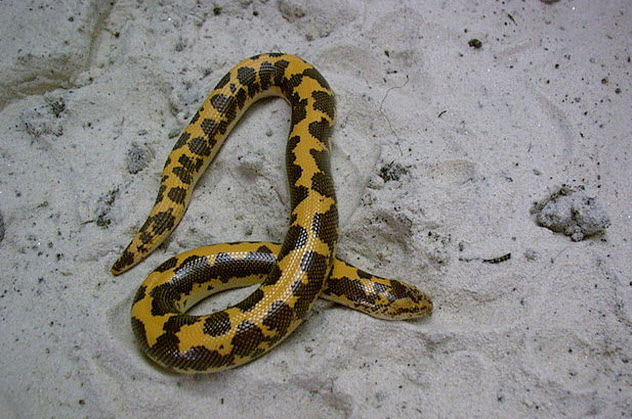
Boa constrictors are known as inhabitants of the rain forest, but the sand boa species are novel boas that have conquered the desert rather than stick to more humid environments. One of the smallest species of boa in the world, the Kenyan sand boa lives most of its life buried under the surface of desert sands or literally living under a rock.
In the cool of the morning and evening when the harsh desert sunshine fades, the Kenyan sand boa emerges from its lair to track, subdue, suffocate, and finally consume its prey whole. It is the sand-dwelling lifestyle of this species that has given rise to some remarkable behavioral adaptations relating to mating and feeding as the snake interacts with its desert environment.
The eyes and nostrils of the Kenyan sand boa are positioned on the head in a manner that limits intrusion of debris into these sensitive areas. Able to live beyond one year without food, this species uses the sand to its advantage while hunting in two ways.
First, the sand boa lies under the sand, seizing prey as it moves past the hidden snake. Second, small prey may be killed by being dragged under the sand and suffocated in the fine grains before consumption.
While feeding supports individual survival, mating promotes the survival of the species, and in this latter area, sand may get in the way. To reproduce, the necessarily persistent male sand boa may actually have to dig his female love interest out of the sand to gain the opportunity to mate with her.
9 Sandfish
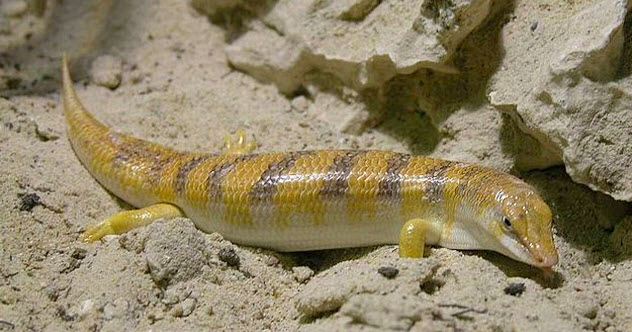
Not actually a fish but a lizard, the sandfish is a distinctive species of skink native to desert environments of North Africa and Southwest Asia. Measuring 15 centimeters (6 in) long with a tan color that assists the lizard in blending in with the desert, this delicate-looking reptile is actually an exceptional specimen of hardy wildlife and desert adaptation.
The sandfish is named after its ability to actually swim through the desert sands, enabling efficient movement and apparently saving it from some of the harshest of the Sun’s rays by being in the sand rather than always on top of it. Able to travel under the sand at considerable speed, sandfish move their legs in a manner comparable to a human swimmer’s crawl stroke as they maneuver and propel themselves among the grains.
A lifestyle of sand swimming requires a further set of special adaptions to withstand its inherent liabilities. Sandfish have smooth, sparkling skin with scales that shine and appear almost fishlike due to their gloss, minus any slime, of course, since reptiles boast dry skin.
However, the toughness of their skin, hidden by its apparent delicacy, allows the sandfish to swish and swerve its way through highly abrasive, silica-based desert sands that would strip many other creatures of their protective covering in short order. Scales cover the ear openings, and transparent eyelid scales protect the sandfish’s vision from the onslaught of grains.
The sharp snout and countersunk jaw allow the animal to push forward into the sand while avoiding the harmful injection of sand grains during movement. Mystery still surrounds some details of sandfish ecology, with more to be learned about their feeding habits.
8 Brewer’s Sparrow
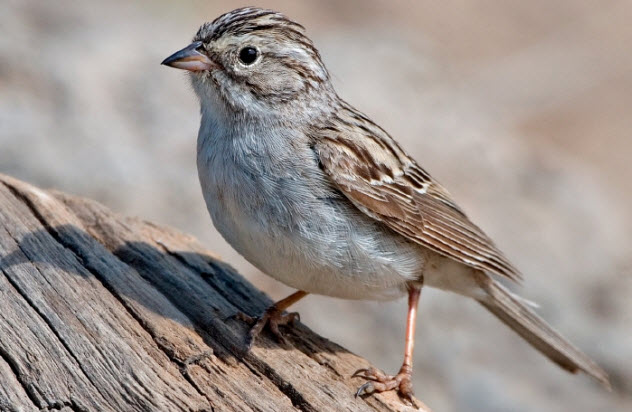
A remarkable application of basic chemistry allows the drab-looking Brewer’s sparrow to survive in deserts where life-giving water is in extremely short supply. Birds typically obtain the majority of their water through soft, wet plant foods, water sipped through the bill from leaves and streams, or the blood and tissue of animal prey.
for much of the year, the desert-dwelling Brewer’s sparrow of North America does not have many luxuries or options when it comes to water sources. This bird feeds largely on seeds which are exceedingly poor in water content but contain carbohydrates. When broken apart, carbohydrates reduce to carbon, hydrogen, and oxygen. When the latter two elements are broken away from carbon and reunited, dihydrogen monoxide (H20), or water, results.
Such “metabolic water,” as the by-products are known to scientists, is produced by all animals, even humans. The Brewer’s sparrow cannot survive entirely on metabolic water, but its ability to derive a significant amount of metabolic water is a tremendous asset in challenging drought conditions.
Compared to larger life-forms, small birds such as the Brewer’s sparrow have an exceptionally high metabolic rate. With its increased metabolic activity, this songbird can produce a greater degree of metabolic water than a larger animal, compensating somewhat for its vulnerability to water loss in desert conditions.
7 Sand Cat

Tiny, sandy, and feline to the fullest possible extent, the sand cat resembles a house cat and stands out as the only species of cat that can be correctly classified as a true desert dweller. The sand cat, Felis margarita, is native to North Africa, Southwest Asia, and Central Asia.
At 24–30 centimeters (9–12 in) tall, the sand cat weighs 1–3 kilograms (3–7 lb) and comes with a perfect suite of adaptations that make this animal uniquely capable of handling the challenges of desert life. Sand cats boast special padded paws covered with long, tough hairs that protect the cats’ feet from hot sand and also help to support their weight among the shifting grains, preventing the cats from sinking.
Extra-large eyes aid the tan-and-reddish striped sand cat in spotting prey, while the large ears gather sound which does not carry as well in the dry desert environment. A thick coat plays a critical role in both insulating the feline from the hottest of summer conditions and protecting it from hypothermia during cold desert nights as the hottest deserts are very cold due to the lack of moisture to retain heat.
Several interesting physical and behavioral adaptations further define the unique life of sand cats. Equipped with dull claws that do not fully retract, sand cats creep along low to the ground, leaving barely a footprint and avoiding burns due to the thick fur on their feet. Burying themselves in the sand or hiding under a bush, the cats are secretive and scarce, presenting a challenge to the biologists willing to study them.
Unfortunately, sand cats are classified as “near threatened” due to increased predation, drought, habitat loss, and human persecution of these remarkable cousins of the ubiquitous domestic cat.
6 Desert Tortoise

While a vast range of shelled reptiles make their homes in wet forest environments, swamps, and the open oceans, chelonians have also conquered the desert. Native to the deserts of the southwestern United States, the desert tortoise Gopherus agassizii and its close, recently split relative, Morafka’s desert tortoise Gopherus morafkai, without fail stand out as remarkable examples of adaptation to desert climes. While the animals look like the biological equivalent of rocks, they have a secret to survival hidden inside those hard, dry shells—exceptional water storage capacity.
The desert tortoise has an impressive but peculiar physical adaptation that allows improved hydration management. This adaptation comes in the form of an oversized bladder that can carry extra water. In this specially evolved bladder, a desert tortoise can carry greater than 40 percent of its weight in urea, uric acid, nitrogen-based wastes, and water.
In wet conditions, the tortoises excrete waste and drink extra water to store in their bladders. As a result, alarming a desert tortoise may prove to be exceedingly dangerous to its survival, causing it to abandon its reserve of water due to fear-based urination.
With their thick rear legs and flatter front feet, desert tortoises have an easier time walking in the sand. In fact, these strong feet are used to carry out an ingenious behavioral adaptation. Desert tortoises dig holes in the ground to catch rainwater before drinking and storing the water in their bladders.
5 Desert Cockroaches
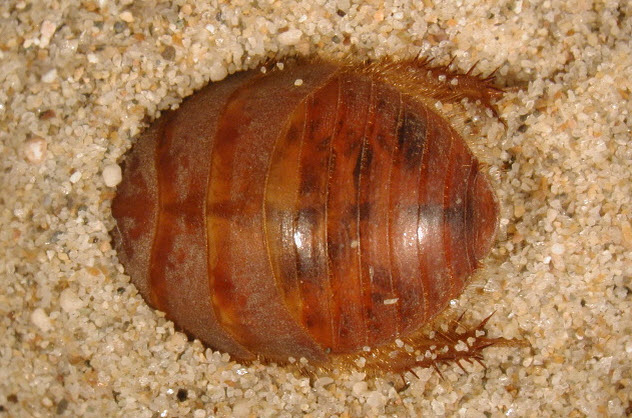
Looking for all the world like modern, land-dwelling trilobites, different species of desert cockroaches make their way through the shifting sands and stones of the Earth’s deserts. In the United States, Arenivaga erratica (Latin for “sand wanderer”) is found. Making ridges in the sand as it moves, the desert cockroach has several captivating adaptations that equip it especially well for desert life.
Finding innovative ways of gathering or retaining water are the hallmarks of desert evolutionary adaptation. In the case of desert cockroaches, a pair of small bladders are located in the mouth. These function by condensing available water from moisture in the air and then conveying it back into the cockroach. Barring any blockage, these bladders will function and deliver moisture to the cockroach.
It is the nocturnal female that looks so close to a trilobite, being wingless and spending time in burrows during the day to avoid light. In contrast, the diurnal, winged males look more like normal cockroaches and are attracted to sources of light.
Being a desert animal, it is also not much of a pest as it has less overlap with humans than many other cockroach species. Feeding on the roots of desert plants allows the desert cockroach to survive while remaining under cover, away from the Sun and predators.
4 Remarkable Cactus Birds
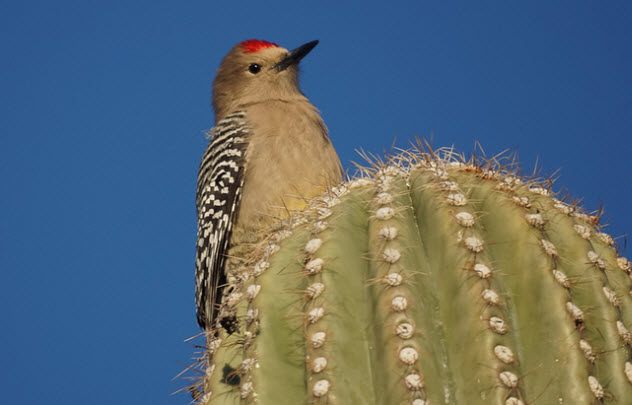
Forests with their vegetation and generally higher levels of moisture create the structural diversity and ecological niche types required by an impressive array of birds that use trees in every imaginable way. Deserts might seem completely opposite to the conditions in which forest birds thrive. But remarkably, the relatively waterless desert supports an ecological equivalent structure in the form of giant saguaro cacti that host several equivalent birds.
Gila woodpeckers drill into the forest-treelike trunks of the cacti, sheltering and nesting in that space. In turn, tiny owls known as elf owls live and nest in the cavities in the treelike trunks and holes of the giant cacti. All in all, we see the makings of a veritable cacti-supported forest ecosystem right in the desert.
If that were not enough, many small songbirds perch and nest among the cacti stands. The largest and most impressive North American wren, the cactus wren, specializes in life among the cacti, even feeding on the fruit in contrast to smaller, almost exclusively arthropod-eating shrub, marsh, and woodland wrens.
The ecosystem resources go even further for at the top of the cacti, dramatic flowers bloom. Flowers produce seeds and nectar, paving the way for songbirds to feed on seeds while desert-dwelling hummingbirds sip from the flowers on top of the cacti. Finally, white-winged doves make their nests in cacti while feeding on the rich, juicy flesh of the cactus fruits.
3 Skin-Drinking Desert Lizards
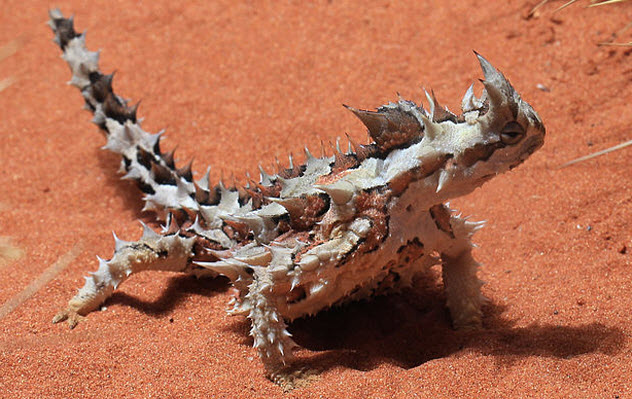
The normal way to get water would seem to be drinking through the mouth. The best way to get water in a desert might appear to be through access to an oasis or the consumption of succulent plants or prey items, however scarce such resources might be.
However, scientific research has shown that another, exceptionally ingenious, and biologically advanced method of gathering water for internal rehydration has emerged among certain lizards. Through examination of Australian thorny devil and Texas horned lizard skin and scale structures, a bizarre physiological adaptation has been discovered. The skin of lizards prevents water loss and also keeps water from getting in through the skin, but a novel way in which lizard skin assists in precision water gathering has developed.
Through the process termed “cutaneous water acquisition” as described in the case of the Australian thorny devil, these lizards use miniature, tubelike channels to absorb and then direct water from the point of contact cumulatively toward the mouth of the lizard. Upon reaching the slightly indented corners of the lizard’s mouth, the water is then sucked in and consumed. Through this adaptation, the lizards are able to gather and then concentrate the water gleaned from rainfall, damp sand, and pools of water encountered on occasion.
2 Desert Pupfish
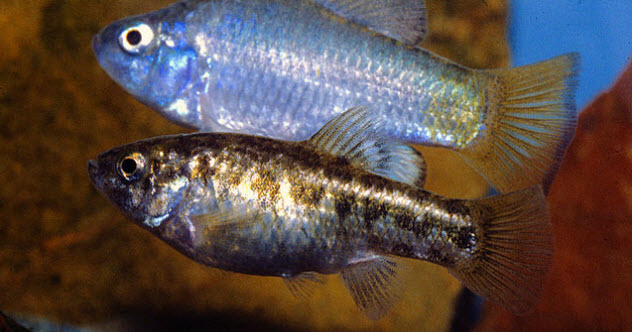
Some like it hot, and others just have to get used to it. Adapted over generations to exceedingly warm water conditions, the various species of desert pupfish are examples of how the desert environment drastically influences even the few aquatic habitats occurring within its bounds.
The desert pupfish are representative of the extremophile class of animals. While desert-dwelling fish might seem to be a contradiction, they are a reality of desert wildlife diversity. Desert pupfish are considered to be living fossils, offering evidence of a historic interconnection among lakes and survival through natural selection to adapt to shrinking and heating bodies of water, including desert pools, springs, marshy patches, and streams.
The adaptations of certain desert-dwelling pupfish can reach extraordinary levels, leading to remarkably restricted ranges, endangered species status, and unimaginable temperature tolerance. The rare Devil’s Hole pupfish lives in an area just over 1 meter (3 ft) wide with a significantly greater depth, while the desert pupfish can survive temperatures of 43 degrees Celsius (110 °F).
The extreme nature of these fish’s adaptation set stands out in many ways, including their remarkably short life span. Devil’s Hole pupfish, recognized and protected legally as an endangered species, may live for only six months to one year. All in all, pupfish stand out as an example of the ability of animal life to ensure that even the most nonstandard habitats are colonized.
1 Greater Roadrunner
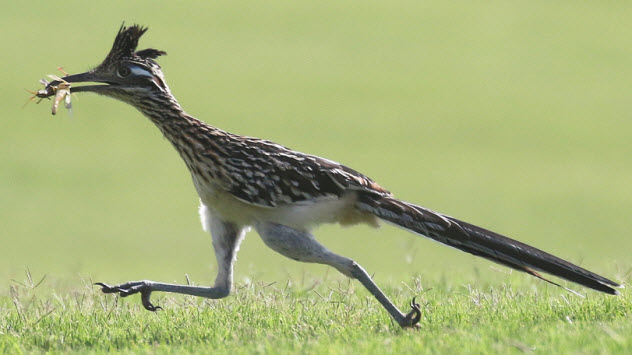
Drinking urine as a last resort for survival may be well-known as an option for humans in the desert, but the greater roadrunner of cartoon fame takes waste product–based survival to the next level in its curious approach to desert life. One of the roadrunner body’s primary ways to tackle water conservation is sure to at once disgust and astound the naturalist. This animal uses water withdrawal and reabsorption from fecal waste.
After consuming a meal, the roadrunner’s digestive system retrieves water from the bird’s feces as they sit in the excretory canals. Prior to elimination, the water is withdrawn through this advanced, unappetizing, and peculiar physiological process, and only then the feces are expelled.
The absorption feat is accomplished through the villi projections in part of the intestinal tract, which absorb water through blood vessels. After absorption from the feces through the blood vessels, the water is transported from the villi into the bird’s bloodstream.
While this adaptation certainly aids survival, one spare tire may not be enough. So the roadrunner has two more impressive hydration management adaptations. One is to hunt prey that provides water through tissue and blood after consumption. Another is to secrete excess salt through glands located above the bird’s eyes. Such desalination glands are typically found in seabirds, not in land birds.
Christopher M. Stephens, Msc., is an ecologist, conservation planning consultant from British Columbia, Canada, with a passion for discovering the most startling secrets of our natural world. He is the birding tour leader for Pacific Rainforest Adventure Tours, offering international visitors the opportunity to see remarkable Canadian birds up close and accepts custom bookings throughout the year. Some of his fondest memories include traversing the cold deserts of America’s Great Basin in Canada and the United States and arid lands in California’s interior, encountering American white pelicans on sagebrush-surrounded ponds and avoiding prickly pear cacti.








